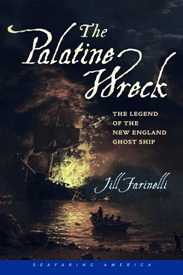 Pirates and Privateers Pirates and Privateers
The History of Maritime
Piracy
Cindy Vallar, Editor
& Reviewer
P.O. Box 425,
Keller, TX 76244-0425
    
Books for
Adults ~ Disasters, Mutinies, & Shipwrecks

The Palatine Wreck: The
Legend of the New England Ghost Ship
by Jill Farinelli
University Press of New England, 2017, ISBN
978-1-61168-705-7, US $19.95
Also available in other formats
    
History
knows her as "Palatine," initially a sailing ship,
then a wreck, and later, a fiery ghost. Her name and
those of most passengers have been lost until now.
For the first time, we finally learn a bit about
fifteen emigrants who set sail in April 1738, aboard
Princess Augusta. The total number who leave
Rotterdam in the Netherlands is uncertain; this
cargo ship carries around 300 men, women, and
children. At least 240 of these die during the
crossing of the Atlantic. Of her crew of sixteen,
half succumb, including one of the principal owners,
Captain George Long, who, at twenty, is making his
first Palatine run.
Princess Augusta was bound for Philadelphia,
Pennsylvania, and the journey to their new homes
should have taken three months. Instead, those who
survived reached the mouth of the Delaware River in
December, only to discover the waterway was frozen
shut. Unable to wait any longer to reach land, the
ship headed north to Rhode Island, where she
grounded and sank off Block Island. A year later,
the first sighting of a full-rigged ship on fire
occurred, but when rescuers reached the site,
nothing was there except water – no survivors, no
dead bodies, no wreckage. From time to time in the
intervening years, the ghost ship has reappeared.
The majority of emigrants come from the Palantinate,
a region in Germany that borders both sides of the
Rhine River. One town in this area is Schwaigern,
where the residents’ lives are controlled by the
market, the palace, and the church. Inheritance
laws, financial burdens, and the possibility of
another war convince many in the region to immigrate
to the New World and many go to William Penn’s
colony because he offers cheap acreage without heavy
taxation or government interference. One man who
decides to leave Schwaigern is Sebastian Dieter, who
takes with him his wife and three children. The
first section of the book, “The Old World,” recounts
what it takes to leave their homeland and the trials
they endure during the journey to the Netherlands
and the wait to board a ship bound for America.
“The Voyage” recounts the crossing of the Atlantic.
Farinelli skillfully weaves a horrific tale where
greed, overcrowding, illness, poor provisions,
delays, and storms impact everyone aboard. Where
specific details about Princess Augusta are
available, she includes them. She fills in missing
information with details of what other Palatine
ships experience. At the same time, she shares the
questions that remain unanswered about this
particular cruise – many of which are mysteries that
will never be solved.
The third portion of the book, “The New Land,”
focuses on what emigrants experience once the ship
arrives on the east coast of America, as well as
what happens to the survivors of Princess
Augusta after she sinks. “The Legend,” the
fourth part, discusses some of the best-known
sightings, John Greenleaf Whittier’s poem “The
Palatine,” the stories of two female survivors who
opt to remain on Block Island, and how the publicity
of the ghost ship forever changes the island and the
islanders’ way of life. The endnotes contain
fascinating historical tidbits beyond identifying
sources. The bibliography includes famous poems and
stories inspired by the Palatine Legend, as well as
primary and secondary source materials. There is
also an index.
The Palatine Wreck is an invaluable addition
to any collection dealing with maritime history and
the immigrant experience. Part of the Seafaring
America series, it delves deeper into the true story
of the fateful journey, while clearly separating
fact from fiction. For example, one persistent
legend is that wreckers lure Princess Augusta
to her death and murder the passengers; Farinelli’s
research clearly shows this is not what happens. Her
spellbinding account reads like a novel but is
totally nonfiction. The manner in which she recounts
what occurs concisely demonstrates that the horror
of the shipwreck is merely the final episode in a
series of tragic events – some man-made, some no one
can control. She immerses readers in the time
period, ship life, and the emigrant experience,
making this engrossing presentation difficult to put
down.
Review
Copyright ©2017 Cindy Vallar

Click to contact me
Background image compliments
of Anke's Graphics |

